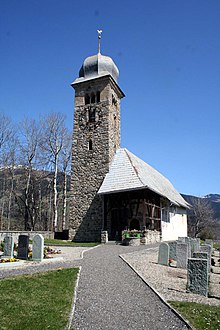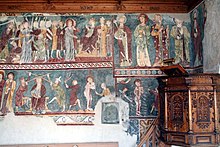Waltensburg Master
The Waltensburg Master was a painter of unknown origin who decorated various churches in Graubünden with pictures in the first half of the 14th century .
His works are spiritually related to the miniatures of the Manessian manuscript that were made around the same time, as well as the stained glass from Königsfelden . He is one of the strongest painters from the High Gothic period .
Waltensburg
He is called the Waltensburg Master because he left his most important work on the north wall of the Reformed Church in Waltensburg in the Surselva around 1330: a well-preserved, high-quality drawing of the Passion cycle.
The painting in Waltensburg covers the entire inside of the north wall, the choir arch wall and the adjacent area of the southern wall. It shows figures of apostles and saints as well as a scene from the legend of Sebastian and Nicholas. More pictures of him can be found on the southern outside on the northwest corner. Here are, among other things - a monumental Michael with the scale to weigh souls as well as fragments of an Adoration of the Magi and the remains - along with other apostles and saints Christopher figure to see. The theologian and religious educator Horst F. Rupp (see list of literature) has referred to several anti-Judaistic representations in this Passion cycle. On the other hand, the art historian David Ganz does not see anti-Judaism overrepresented in this work.
Working method
As was customary at the time, the Waltensburg master will also have worked with journeymen who carried out the simpler work. The more demanding areas such as faces were reserved for the master himself. There is some evidence that the master used a sample book with models of figures, decorations and animals.
For example, Christ on the Scourge Column and Sebastian right next to it are based on the same template (see picture on the right) and the conversation in Simon's house in Dusch shows the same composition as the Last Supper in Waltensburg.
person
One does not know who the master was; there is no information about his person. Just as little is known what brought him to Waltensburg and who could pay him; the simple peasants hardly. The more recent research suspects it from the Lake Constance area.
Another assumption is that the artist was Austrian and was loaned by the Habsburgs to befriended Barons von Vaz . The first work by the master can indeed be found in Brandis Castle in Maienfeld, which was prepared around 1320 for the wedding of Donat von Vaz with Guta von Ochsenstein, who is related to the Austrians. In addition to depictions from the Old Testament, he also painted secular scenes from an inn or from the grape harvest.
Works
Further works by the Waltensburg master can be found in the churches of Sogn Gieri and Sogn Paul in Rhäzüns , in Casti-Wergenstein , in the Cathedral of Chur , in Churwalden , Clugin , in Dusch bei Paspels , in Brandis Castle in Maienfeld and in the Church of S. Zeno in Lüen in Schanfigg.
museum
In 2013 a museum about the work of the Waltensburg master was opened in Waltensburg. It stands opposite the church and gives an insight into his work, a time and related art from the High Middle Ages.
photos
Waltensburg Reformed Church
Sogn Gieri near Rhäzüns
Sogn Paul in Rhäzüns
Chapel Maria Magdalena in Dusch ob Paspels
Church of St. Maria and Michael in Churwalden
S. Zeno Church in Lüen
Casti Church
Clugin Church
Pitasch Church
Chur Cathedral
literature
- Terra Grischuna : 2/2007.
- Hans Batz: Churches and chapels of the canton of Graubünden. Desertina, Chur 2003-2005.
- U. Caflisch: Art Guide Evangelical Church Waltensburg / Vuorz. Waltensburg / Vuorz rectory; without year.
- Horst F. Rupp: High art and hatred of Jews - A new look at old pictures. The Passion Cycle by the Waltensburg Master. In: Journal for Swiss Archeology and Art History, Volume 71/2014, Issue 2/3, pp. 161–186.
- Horst F. Rupp: A new look at the Waltensburg Passion Cycle. In: Bündner Monatsblatt 2/2014, pp. 175–197.
- Horst F. Rupp (ed.): The Waltensburg master in his time. Kunstverlag Josef Fink and Bündner Monatsblatt , Chur 2015, ISBN 978-3-89870-883-8 .
- Horst F. Rupp: Master of Waltensburg. In: General Artists Dictionary (AKL). The visual arts of all time. Edited by Andreas Beyer, Bénèdicte Savoy and Wolf Tegethoff . Volume 88.De Gruyter, Munich / Berlin / New York 2015, pp. 525f.
- Horst F. Rupp: Observaziuns davart il master da Vuorz. Exemplificadas specialmein en connex cul ciclus dalla passiun da Vuorz. In: Per Mintga Gi. Calendar popular per las valladas renanas 94/2015, pp. 134-147.
- Horst F. Rupp: Puncts centrals davart il discuors actual sur dil Meister da Vuorz. In: Per Mingta Gi. Calendar popular per las valladas renanas 95/2016, pp. 158–166.
- Franz Lorenzi: On the artistic origin of the Waltensburg master. In: Bündner Monatsblatt , 3/2015, pp. 256–271.
Web links
- Marc-Antoni Nay: Waltensburg Master. In: Historical Lexicon of Switzerland .
- Annegret Diethelm: Master of Waltensburg. In: Sikart
- Museum of the Waltensburg Masters
Individual evidence
- ↑ Description and reviews on the Kulturforschung Graubünden website , accessed on October 21, 2015.
| personal data | |
|---|---|
| SURNAME | Waltensburg Master |
| BRIEF DESCRIPTION | painter |
| DATE OF BIRTH | 13th century or 14th century |
| DATE OF DEATH | 14th Century |





























